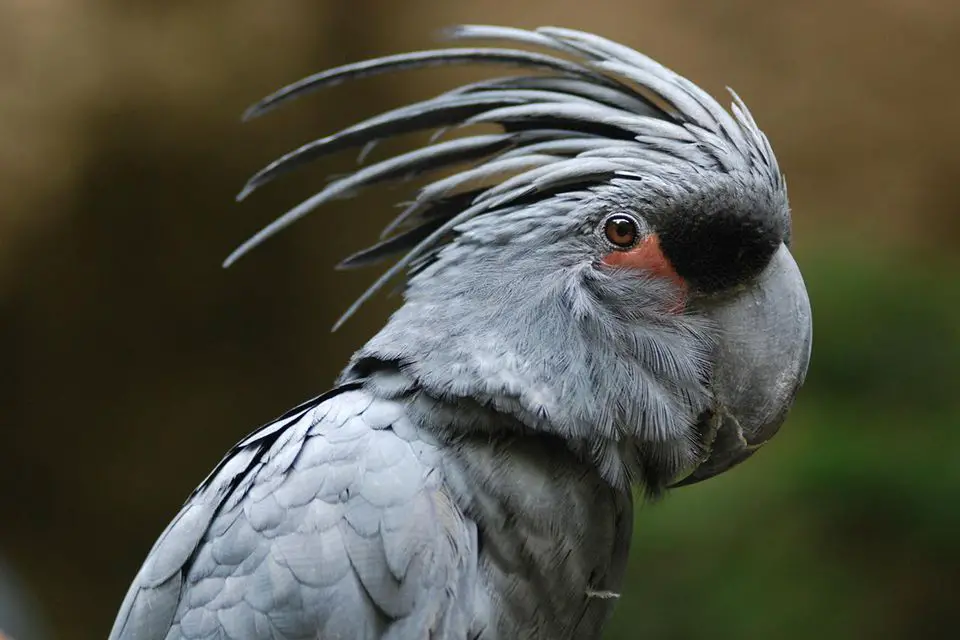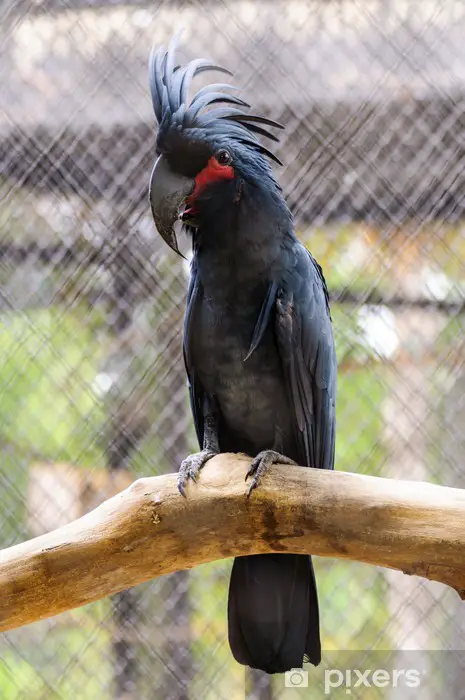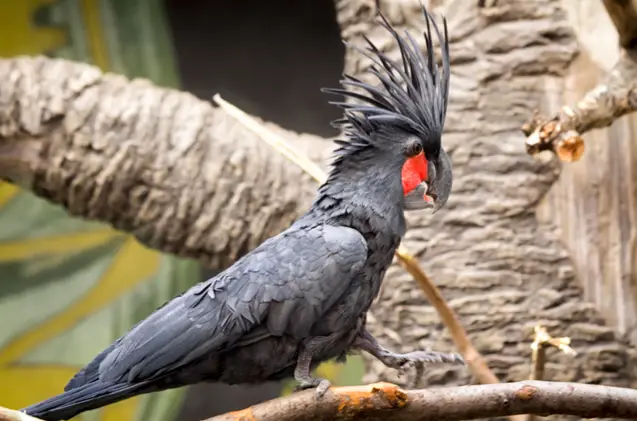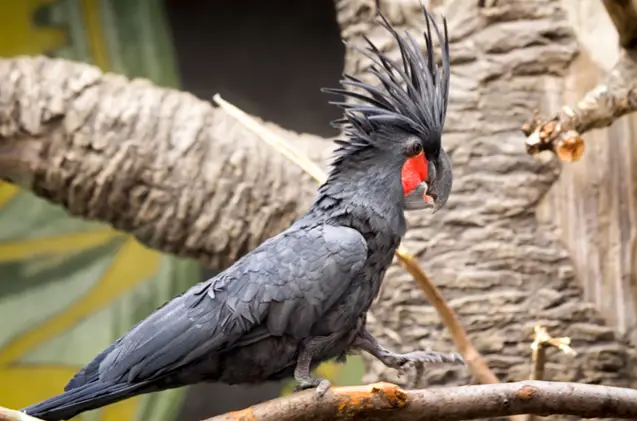Scientific Facts
| Common Name: | Palm Cockatoo |
| Scientific Name: | Probosciger aterrimus |
| Life Span: | Up to 100 years |
| Weight: | Up to 1,100 grams |
| Length: | Up to 68 centimeters |
| Habitat: | Rainforests and Savannahs |
| Country of Origin: | Northern Australia, Papua New Guinea |
Physical Description

Palm cockatoos are the largest of all parrots, and they range from 49 centimeters to 68 centimeters in terms of their height. They also weigh about 500 grams to 1,100 grams, with the females ranging from about 500 to 950 grams, and the males weighing about 540 to 1,100 grams. Their wingspan reaches around 35.1 centimeters, their tail length is about 23.8 centimeters, their bill reaches about 9.1 centimeters, and tarsus length is about 3.5 centimeters.
Also, palm cockatoos are colored almost entirely black except from the 15 centimeters long erectile crest at the top of their heads. Their beaks never really close completely, which always slightly reveals a bit of their black-tipped red tongues. This mouth, which is a little open, makes it much easier for these birds to hold nuts inside their mouths and crack them on their own. Their strong mandibles are also used for cracking nuts. Their legs are colored with both grey and black, with a few feathers on their thighs. But, their most distinguishing characteristic is their red facial markings.
For the palm cockatoos, their skin changes color based on their stress levels and how healthy they are. When they are highly stressed, while when the birds are highly excited, their skin changes to yellow. For juveniles, the under feathers are lined with a pale yellow.
Conservation Status

Palm cockatoos are considered near threatened and low-risk due to the destruction of habitat with seasonal fires and logging. Additionally, in the 1970s, keeping palm cockatoos as pets became quite famous, and since then, they have been the object of hunting for the aviary trade. In fact, arrows with sticky resin have been the most popular capturing tactic used by illegal traders. Nowadays, there are now laws that prohibit palm cockatoo exportation, and all transport of these birds as pets require permits. Unfortunately, the illegal exportation and sale of these birds are still rampant.
According to the IUCN Red List, as of the last global assessment of October 2016, the palm cockatoos are of least concern in terms of being extinct among the list of endangered species. The number of mature individuals is currently unknown, but the population trend has been studied to be decreasing.
Availability and Natural Habitat

Palm cockatoos are naturally found residing in the Australasian region, which includes the territories of Aru Islands, Cape York Peninsula or Northern Australia, Misool Isle or Western Papuan Islands, New Guinea, West Irian, and other islands nearby. They usually occupy the rainforests, dense savannas, eucalypt woodlands, forest edges, gallery forests, monsoon woodlands, paperbark woodlands, partly cleared areas, and other spaces. The palm cockatoos choose large trees to serve as their nests for their young. During the day, they roost near food and water sources, while during the night, they roost near a nesting tree.
Lifespan
The lifespan of palm cockatoos in the wild is not well known. But, it is believed by experts that the palm cockatoos usually live from 40 to 60 years. On the other hand, it has been recorded that captive cockatoos can live to more than 100 years old.
Behavior
In terms of behavior, captive palm cockatoos and those in the wild behave differently. Those in captivity may develop some compulsive behaviors, like picking on their feathers. These birds can also mimic the sounds and language of humans. But, even palm cockatoos in the wild are known to accept food from humans, and they also raid bird feeders. When their food sources are low, these cockatoos have been known to chew up decks and side paneling on homes.
Palm cockatoos can also be seen living alone, in pairs, and in larger groups. They also spend a lot of their time high in the canopy of a forest or flying between foraging areas and roosting places. These birds are also seen feeding in large groups where one sentinel bird will beware of encountering predators. If there is a predator or any other threat that should appear, the sentinel cockatoo gives an alarm cry to alert everybody else in the flock. The palm cockatoos are very social, gathering in groups in the early hours of the day in their favorite locations.
During rainy conditions, they can be found hanging upside down with their tails, and their wings stretched out as if taking a bath.
Black palm cockatoos can become good pets, when well-trained, but generally, owners should not expect them to be as affectionate as other types of parrots. These palm cockatoos demand a lot of attention from their owners, so they should be provided with time, effort, and consistency to remain healthy.
Palm cockatoos are also one of the few bird species that are known to use tools. In their natural habitats, palm cockatoos are known to use a large stick in order to drum against a hollow tree before choosing where to build a nest. This behavior has no explanation, and it actually puzzles a lot of scientists who are fascinated with the species.
Communication
Palm cockatoos make one of the loudest whistling calls, which makes them one of the loudest species of parrots. The most common call heard is the contact call, which is a disyllabic whistle. When they are alarmed, these cockatoos can produce a harsh and sharp screech. Other calls that they make include screeches, whistles, cries, wailing, mournful sounds, and grunting. Another way these birds communicate is by stomping on their wood perches, using nuts and sticks to drum against the tree, sometimes even as many as 200 times. Usually, this is usually shown to promote their territorial boundaries. When these things happen, their cheeks will change color with health, mood, and stress. They also use their erectile crest to communicate the mood.
Exercise and Training
The large palm cockatoos require a lot of exercises to remain in optimum health levels. Keepers must allow these birds a minimum of three to four hours of playtime outside of their cages, so they can stretch their muscles and play. They should still be supervised whenever they spend time outside their cage so that accidents can be prevented, and undesired chewing will not be done in furniture, walls, and other areas in the household.
For keeping your birds out of unnecessary trouble, provide them with numerous toys that they can chew on. Keepers must give palm cockatoos some stimulation exercises using ropes and wooden toys. In case these toys get worn out, make sure that you have other pieces in handy whenever you might need to replace them. You should also install swings, ladders, perches, and play stands to help the palm cockatoo burn out their extra energy.
Food and Eating Habits
The palm cockatoos mainly consume buds, fruits, and seeds. At times, these birds also consume insects and their larvae. They also primarily forage in the canopy of the forest for fallen seeds and fruits. They love crushing seeds and hard fruits with their strong and sharp mandibles.
Like other species of cockatoos, these birds are highly prone to becoming overweight, so owners must be extremely careful to supervise their fat intake and not feed them too much. A balanced diet for palm cockatoos must consist of high-quality pellets, a good amount of seed mix, and daily servings of fruits and vegetables. This type of diet is very similar to their diet in the wild.
Breeding
During their mating sessions, the male and female palm cockatoos approach each other with their wings extended. Before they start, the male creates loud whistles and bows numerous times during which the skin on their faces will usually become a deep red. Sometimes, the male palm cockatoos also bang a stick against a tree to call out their partners, as a territorial gesture near the nesting site. Palm cockatoos are monogamous birds and stay with one another for their entire lives.
The mating season can vary depending on the specific climate in the locality, but it is usually from August to January. Palm cockatoos cannot excavate their own hole for nesting cavities. Instead, they just find previously hollow cavities in large palm trees. Their nesting holes tend to be about 1 meter in-depth, and 25 cm to 60 cm in diameter are linked with a pile of broken twigs at the bottom, upon which the egg rests. They oftentimes come back to the same site year after year.
Palm cockatoos only lay one egg per clutch, which is then incubated for about 30 to 33 days. The newly-hatched young are naked and helpless. The young take about 100 to 110 days to fledge, the longest period to fledgling of any other parrot species.
After leaving their nests, the young palm cockatoos are dependent on the parents for at least another 6 weeks due to their inability to fly. After this, the young palm cockatoo will be independent but will stay relatively close to their parents until the next breeding season comes. During the new season, the parents will evict the previous year’s young from their territory. Young palm cockatoos are estimated to reach sexual maturity at 7 to 8 years old.
Although both parents participate in incubation, the females incubate the egg more than the males. Then, the males spend most of their time foraging for food. After the eggs have hatched, the chicks are mostly brooded mostly by the females. The males also brood their children, but they are also mainly responsible for searching for food. After the chick leaves the nest, both of the parents provide food and protection for it until it is fully independent.
Common Health Problems
In protecting the health of your pet cockatoos, you should know how to recognize the sick ones. Here are the common symptoms of sick cockatoos:
- Losing weight or general state of being skinny
- Refusing to eat
- Noticeable sounds when breathing
- Having slime or fluid near their eyes or nose
- Having fluid running from their nose
- Sleeping too much
- Keeping their eyes closed for a long time
- Keeping their feathers puffed up
- Displaying a response that is slower than normal
If you are looking into purchasing a cockatoo that shows one or more of these symptoms, you can opt to wait until the problems have been cleared before you proceed with your purchase. Buying a sick cockatoo will only lead to possible heartache and future trouble. This can also be a very expensive thing to find treatment for the palm cockatoo.
Sometimes, a palm cockatoo that has been infected by a virus will not show any signs of illness. The cockatoo can be a carrier of the disease, meaning it has the virus in its body and can spread the virus to other birds. These illnesses that are notorious for taking a while before occurring are Giardia, Polyoma, PBFD, and Psittacosis. The immune system of a palm cockatoo that also serves as the carrier of the disease will keep it in check, but this does not prevent from spreading and surfacing in the future. At some point, the carrier can also get sick as well, but sometimes it can never show any symptom forever carrying the virus throughout its life.
If you want to check for the presence of these diseases, you can go to an avian vet and have your birds blood tested. They will check for the DNA of the viruses in the blood of the cockatoo, which is the surest way to check for the presence of unlikeable diseases. This is why when you purchase a parrot; it is important to require a vet check-up before a purchase is pushed through. This does not only ensure getting a healthy pet. This act will also make sure that there will be no possibilities of spreading around diseases to other palm cockatoos and different species of birds.
Environment and Housing
A palm cockatoo can be housed in a cage or an aviary. No space would be too big for a cockatoo and remember that the more space you have, the better. Palm cockatoos will be much happier to spend time in larger cages, so opt for them if you have space and the budget to do so. A larger living area will give your cockatoo more space to move and enjoy their life.
So, technically, there is no maximum cage or aviary size. But, of course, there is a minimum. The rule of thumb is that the palm cockatoo should be able to stand upright in it is a cage with their wings spread without having to touch the bars of the cage.
For an additional requirement, horizontal bars are so much easier to climb compared to vertical bars. If you can be given a choice, you should opt for horizontal bars. Many bird cages contain a metal grid rack at the bottom of their cage. This metal rack separates the bird from their droppings and the sand. Though owners might think that this thing is uncomfortable for the bird can walk on. If you clean the cage daily, there would technically be no reason to install a grid like this.
Also, where you choose to place the cage of a palm cockatoo can also affect the bird’s well-being. Because palm cockatoos enjoy being around humans, placing them in the living room is surely a great idea. But, when doing this, you should place the bird’s cage in a corner or against a wall, so the bird will feel like they will have space where no predators can approach them. Remember, you should not place the cage of a cockatoo inside the kitchen because they might die from breathing due to the fumes made by cooking.
Keepers should also check for the safety and security of the cage that they buy. Though a cage is marketed to be made for parrots, it does not mean that this cage is 100 percent escape-free. The most common problem is that the doors of the cage can easily be opened by clever palm cockatoos. When they escape when their owners are not at home, the cockatoos can get into trouble by flying into live wires, being electrocuted, getting lost, or getting caught by a predator or a human.
For checking on the security, owners must make sure that there will be no sharp edges inside the cage, no plastic parts that can be broken down by the bird, and that there are no holes big enough for a cockatoo to stick its head through.
Fun Facts about the Palm Cockatoo
- The black palm cockatoo is also known as the great black cockatoo, black macaw, and goliath cockatoo.
- Male and female palm cockatoos are very similar in size, which is why DNA testing is required to identify the gender of these birds.
- Palm cockatoos are almost totally black in color, with cheek patches that are bare and are the color of crimson.
- According to Australian wildlife experts, the palm cockatoos use the Torres Straits to migrate between Australia and New Guinea.
- The cheek patches of the palm cockatoo go brighter and darker, depending on whether the bird is feeling threatened or feeling excited.
- Black palm cockatoos are very energetic birds, and they require lots of exercises for them to stay healthy.
- Palm cockatoos are sociable, and they can get along with other birds when placed in an aviary, but palm cockatoos can be a potential danger for children because they have strong beaks.
- The palm cockatoos have the largest bill out of all the parrots but except the hyacinth macaw.
- Palm cockatoos make loud whistling calls that are the loudest among the parrot species. Their most common call is a contact call, which consists of a whistle of two syllables. Whenever they feel alarmed, these birds make a harsh and sharp screech.
- Palm cockatoos also communicate by stomping their feet on their perch, drumming against trees using nuts and sticks, usually to announce their territories.
Where Can You Get a Pet Palm Cockatoo?
Palm cockatoos can be bought from established avian breeders and sellers. These breeders must be skilled and reputable enough to prove that they take care to raise them in good environments, which are free of contamination and congestion.
Before adopting a palm cockatoo, it would be great to contact breeders to see if you can be allowed to spend some time with the birds. Getting to know someone who has hands-on experience in raising unique birds like the palm cockatoo will help you decide on whether this specific cockatoo species will be the right match for you.
You should also be sure that the bird you are trying to acquire is not caught from the wild. This is because palm cockatoos from the wild can no longer be tamed. Also, because the palm cockatoos are a protected species, you will have to secure a CITES permit, which proves where the bird has originated before you acquire one.
How to Care for a Pet Palm Cockatoo?
In caring for a palm cockatoo, here are essential things that an owner must consider:
- Palm cockatoos can tolerate varying temperatures, but they should not be exposed to temperatures that are below freezing in their enclosures.
- Palm cockatoos are best kept in cages that are about 8.5 feet by 13 feet by 8.5 feet. Bar spacing should be 1 inch apart, and their cages need to be sturdily constructed to stand up to the strong beak of the palm cockatoo.
- Beak trimming and nail trimming might be required, especially if the native pandanus nuts cannot be supplied.
- These birds enjoy baths, and they should regularly be given the opportunity to get their feathers wet.
- Feeding the palm cockatoos should involve a high-quality pelleted diet with at least half of it being composed of vegetables, nuts, and fruits. Obtaining nuts from their natural environment can be an excellent option for palm cockatoos.
- Palm cockatoos need physical exercise in order for them not to become overweight. This instance can be avoided by play stands, ladders, and perches.
Remember that you should only get a palm cockatoo as a pet if you know that you can provide the needed expenses for acquiring and taking care of this bird. If money would not be a constraint, make sure that you can devote a lot of time to successfully take care of this magnificent bird.
A palm cockatoo would also not be appropriate for bird keepers who reside in apartment complexes or condominiums. This is because palm cockatoos have one of the loudest calls that are very distinct. Their natural vocalizations have a human-like sound, and they are considered as one of the best talking cockatoos.
Black palm cockatoos should also not be left alone for more than eight hours in a day. If you are someone who has other obligations, like work or school, this bird might not be a good fit for you.
Frequently Asked Questions
How much does a palm cockatoo cost?
A palm cockatoo is commonly sold for 16,000 US Dollars. It can be expensive because these palm cockatoos are very hard to breed with very high demand.
Do palm cockatoos make good pets?
The palm cockatoos can be a good pet, but possible keepers should not expect them to be as affectionate as other parrots. They require a lot of attention, but they are very social and intelligent birds.
Are palm cockatoos endangered?
At present, the palm cockatoos are still enlisted as a species of least concern by the IUCN Red List.
Why are black palm cockatoos so expensive?
Black palm cockatoos are expensive because they can be rare in many parts of the world.
Are palm cockatoos aggressive?
All types of cockatoos, including the palm cockatoo, can be aggressive, which is shown by biting or lunging at people or animals they see as threats.
How long do palm cockatoos live?
In captivity, a palm cockatoo can live for over 60 years.
What do palm cockatoos eat?
The diet of a palm cockatoo usually consists of seeds, fruits, leaves, and buds. On rare occasions, these birds are also seen eating larvae and other insects.



